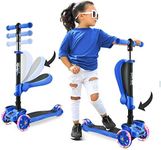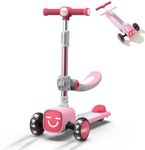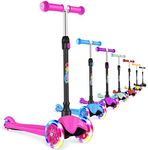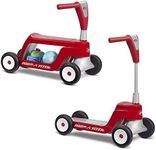Buying Guide for the Best Scooter For Toddlers
Choosing a scooter for toddlers is an exciting step in helping your child develop balance, coordination, and confidence. The right scooter should be safe, easy to use, and suitable for your child's age and abilities. When shopping, focus on features that enhance stability and safety, and always consider your child's size and skill level. Remember, a good fit will make learning to ride fun and encourage your toddler to be active.Number of WheelsThe number of wheels on a toddler scooter affects its stability and ease of use. Most toddler scooters have either two or three wheels. Three-wheeled scooters are more stable and are ideal for beginners, as they help prevent tipping and make balancing easier. Two-wheeled scooters require more balance and are better suited for older or more experienced toddlers. If your child is just starting out, a three-wheeled scooter is usually the best choice.
Wheel Size and MaterialWheel size and material influence how smoothly the scooter rides and how well it handles different surfaces. Larger wheels roll more easily over bumps and cracks, making the ride smoother, while smaller wheels are lighter and easier for little ones to maneuver. Wheels made of soft rubber or polyurethane provide better grip and a quieter ride, which is important for safety and comfort. For most toddlers, medium-sized, soft wheels are a good balance between stability and ease of use.
Handlebar Height and AdjustabilityThe height of the handlebars should match your child's height to ensure comfortable and safe riding. Adjustable handlebars are a great feature because they allow the scooter to grow with your child, providing a longer period of use. When choosing, look for handlebars that can be set at or just below your child's chest level. This helps them maintain control and reduces the risk of falls.
Deck Size and HeightThe deck is the part of the scooter where your child stands. A wider deck offers more stability and is easier for toddlers to balance on, while a narrower deck can be lighter and easier to steer. The height of the deck from the ground also matters; a lower deck makes it easier for toddlers to get on and off and helps them push with their feet more comfortably. For most toddlers, a wide, low deck is the safest and easiest to use.
Steering MechanismScooters for toddlers typically use either a lean-to-steer system or a traditional handlebar steering. Lean-to-steer means the child leans in the direction they want to go, which helps develop balance and coordination. Traditional steering works like a bicycle, turning the handlebars to change direction. Lean-to-steer is generally easier and safer for young children, as it prevents sharp turns and sudden tipping.
Weight LimitThe weight limit tells you how much weight the scooter can safely support. It's important to choose a scooter that can handle your child's current weight and allow for some growth. Exceeding the weight limit can make the scooter unsafe and cause it to wear out faster. Always check the manufacturer's recommended weight range and pick a scooter that fits your child's size.
Safety FeaturesSafety features like non-slip decks, easy-to-use brakes, and rounded edges are crucial for toddler scooters. A non-slip deck helps prevent falls, while a simple rear brake allows your child to stop easily. Rounded edges and sturdy construction reduce the risk of injury. When choosing, prioritize scooters with these built-in safety features to give your child the best protection while riding.















